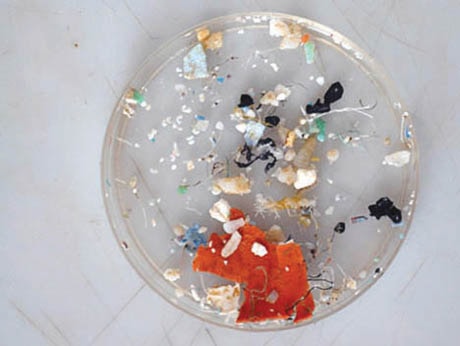It’s a fact: plastic debris in the oceans of the world negatively affects phytoplankton. Phytoplankton is the ‘sea-grass’ the microscopic vegetation that forms the basis of the oceanic food chain. It is also responsible for much of the carbon dioxide absorption in the world, making it a crucial element in the carbon balance of the planet.
“Phytoplankton are tiny, single-celled floating plants. They inhabit the upper layers of any natural body of water where there is enough light to support photosynthetic growth. They are the base of the ocean’s food web, and their production helps to regulate the global carbon cycle. They also contribute to the global cycling of many other compounds with climate implications.” — http://www.pharmasea.ca/phytoplankton_research.html
The problem is that plastics are invading the world of phytoplankton. As noted by Marquita K. Hill of the book Understanding Environmental Pollution, “Plastics do not biodegrade, but break up into smaller and smaller pieces, and finally microscopic bits. Even tiny one-celled phytoplankton can absorb these bits.”
This view is supported by a recent study published in the September edition of the Journal of Physical Chemistry entitled: Physical Adsorption of Charged Plastic Nanoparticles Affects Algal Photosynthesis.
“Using a CO2 depletion assay, we show that the adsorption of plastic beads hindered algal photosynthesis, possibly through the physical blockage of light and air flow by the nanoparticles. . . . plastic adsorption promoted algal ROS [reactive oxygen species] production. Such algal responses to plastic exposure may have implications on the sustainability of the aquatic food chain.”
The ROS referred to are chemically reactive molecules with oxygen that are damaging to cellular structure.
According to Scientific American reporter Steve Nadis phytoplankton constitutes “ an unseen ‘forest’ of microscopic beings [that] fills the upper 200 meters of ocean, exerting an influence on this planet every bit as profound as the forests on land. The diverse phytoplankton species inhabiting the ocean’s surface waters — which mainly consist of single-celled cyanobacteria, diatoms and other kinds of algae — form the base of the marine food web. They account for roughly half the photosynthesis on the earth, remove nearly as much carbon dioxide from the atmosphere as all land plants, and supply about half the oxygen we breathe. Without the activities of these free-floating plantlike organisms, atmospheric carbon dioxide levels would triple.” — http://www.scientificamerican.com/article.cfm?id=the-cells-that-rule-the-s
Some 20 odd years ago researchers from the Woods Hole Oceanic Institute discovered “marine cyanobacteria from the genus they later named Prochlorococcus. . . the smallest and most numerous photosynthetic organisms known . . . responsible at times for more than half the photosynthesis in the seas.”
The problem for phytoplankton (and us) is survival. Plastics are crowding them out. Suspended plastics create barriers to light.
“Just to get an idea of the relative prevalence of these ‘plastic plankton,’ Captain Moore recently sampled water from the gyre and analyzed it using electron microscopy. He discovered that the ratio of plastic particles to phytoplankton in this water — water that came from the remotest part of the world’s largest ocean — is six to one. Six particles of plastic for every phytoplankton!” — http://www.algalita.org/index.php
And plastic sinks as well as floats. Other researchers report how sinking marine debris, particularly plastic, takes ‘everything’ with it to be “doomed to a slow and yet permanent entombment.” Further, “the blanketing effects of plastic sheeting on the sea floor could lead to anoxia and hypoxia induced by inhibition of gas exchange between pore water and sea water,” meaning that the water between the grains of sand on the bottom can no longer release or accept gaseous exchanges.
We understand from recent research that phytoplankton has declined some 40 per cent. All the plastic ever made is still with us; most of it in the ocean where it is killing our world. Phytoplankton’s role is carbon dioxide absorption. Rising levels of carbon dioxide acidify the oceans.
“Even more important are the phytoplankton known as diatoms, the base of the marine food chain. “If they go, it would be like having no grass on land, nothing else could survive,” says Ben Halpern, lead author of a map published in 2008 by the University of California, Santa Barbara. The researchers found that over 40 per cent of the world’s oceans are heavily degraded while less than four per cent are relatively pristine.
“We could trigger a mass extinction on a scale not seen for 100 million years,” warns Richard Norris, Professor of Paleobiology at the Scripps Institution of Oceanography. “Ocean acidification is a bigger problem than global warming.”
And we have a visual warning from the deep: “Numerous white plastic shopping bags suspended upside down and freely drifting in the ocean at water depths of 2000 meters — and looking like an assembly of ghosts.”
Only three to five per cent of plastics are recyclable. Stop the plastics, before they stop us.
My suggested best read about plastic marine debris for the general public: http://rstb.royalsocietypublishing.org/content/364/1526/2013.full
Michelle Stirling-Anosh is a Ponoka-based freelance writer.
